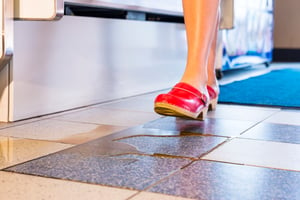
It’s very important that your store has a sound policy in place to keep aisles clear and dry.
Detailed and documented floor inspection and cleaning protocols are vital. During rainy and snowy seasons, the floors in main traffic areas should be inspected by someone every 30 minutes. If wet spots are found, WET FLOOR or CAUTION signs should be placed in front of the area. An employee should mop up the wet area as soon as possible, keep floors dry, and rugs and mats flat and in good condition.
Industrial rugs and mats can also be trouble spots. While they create a non-slip surface, help soak up water, and collect sand and salt, they can also create a trip and fall hazard, particularly for elderly customers who may shuffle their feet or those who wear high heels.
If a customer presents a slip and fall claim, be sure to follow the proper procedures:
- Make sure the customer receives proper medical attention.
- Photograph the area to illustrate what the surface conditions were like.
- Document any unusual circumstances.
Having sound and documented floor inspection and cleaning policies can significantly reduce the likelihood of slip and fall accidents. They can also provide evidence your insurance company may need to defend a suspected fraudulent claim.
This blog was written by Mike Himes, Senior Loss Control Representative for West Bend.




